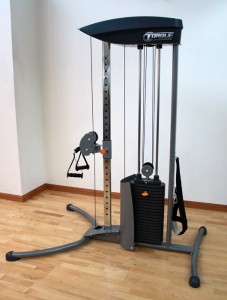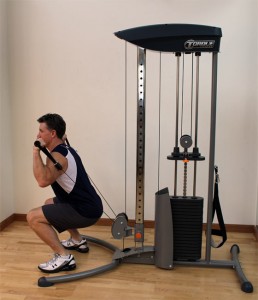12 Feb Five benefits of owning a functional trainer

Functional trainers such as this Torque Fitness F1 offer a great way to meet your specific workout needs and take up less room than home gyms.
Both types of fitness equipment have their advantages.
Here are five benefits of owning a functional trainer:
1. Lots of options – The functional trainer provides an extremely wide-ranging number of options for exercises a person can do because the cable doesn’t have to follow a fixed plane. As a result, more sports specific routines can be implemented.
2. Anyone can use them – People of any background can benefit from functional trainers.
An exercise ball can even be used during a workout on a functional trainer, by sitting on it and pulling the cable handle toward you at a variety of angles.
3. Meets your needs – Functional trainers cater to people specific strength needs If you are looking to improve how you feel and perform during the course of everyday activities, or sport specific movements, it’s a great piece of exercise equipment to consider using is a functional trainer.
Simply put, functional training is any type of exercise that has a direct relationship to the activities you perform in your daily life.
From distance runners, to baseball players, to carpenters, to homemakers, functional training can help you strengthen muscles for the specific demands you put on them on a daily basis.
4. Great for rehab – Functional training traces its roots in rehabilitation, when physical therapists developed exercises to mimic what patients did at home or work in order to return to their lives or jobs after an injury or surgery.
5. Cost effective – Functional trainers usually don’t cost as much as traditional home gyms, and oftentimes require less space. Functional trainers have weight stacks on their base, but the weights are moved by a cable system that comes with different shaped handles.
Final analysis: Functional trainers can be a little harder to use at first because they don’t move on a fixed plane, like traditional home gyms. This can make it a little tougher to know if you’re doing exercises correctly and some people aren’t sure if they’re following the right motions. It’s important that they ask questions when contemplating buying a functional trainer and have correct information and training on how to use them.
At Home Fitness consultant Aaron Dorksen’s blog deals with a variety of fitness topics, ranging from workout tips, motivational ideas and feature stories on how exercise impacts people’s lives. Consult a doctor before making any significant changes in your exercise routine or diet. E-mail him with comments, questions or ideas for future blogs at aaron@athomefitness.com


